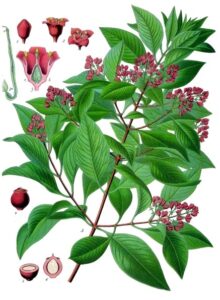Herb of the Week- Sandalwood (Santalum album)

Botanical Name: Santalum Album
Planetary Influences: Jupiter and the Moon
Element: Water
Magical Uses: Purification, Consecration, Initiatory, Spiritual Awareness, Abundance, Funerary
Sandalwood is a set species of wood known as Santalum. The aromatic wood is considered one of the most valued botanicals in the world. Sacred to various religions such as Hinduism, this herb has become especially valued.
Sandalwood is also associated with most Hindu deities as well as Venus, Hathor, and is directly connected to the energy of the Empress Card in the Tarot.
In 1792, the ruler of Mysore province in India, Tipu Sultan, issued an edict in which he declared Sandalwood to be a “royal tree.” Tamil Nandu and Karnataka provinces followed suit, keeping sandalwood under direct governmental control. This posed more problems than it solved. That meant that common people could not plant the trees on their own land. It proved no hardship to the state or religious organizations for a long time because it was found in abundance in forests. For private property owners, however, they stayed away from planting something that they had no control over or could become a potential liability.
It wasn’t until 2002 that property owners in India could legally grow sandalwood on their land. While property owners can now legally grow sandalwood on their property is stolen, the property owner could find him or herself in big trouble.
It isn’t any wonder that sandalwood has been so valued. It was often used to consecrate sacred space, both public and private temples and religious ceremonies. It was considered one of the anointing oils for all major deities in the region, as well as for initiations of priests. That may be in part because the chemical constituents found in the aromatic oils found in the wood and essential oil serve to deepen meditation by encouraging calm and focus. Malas made of sandalwood beads are still being produced and used today.
Sandalwood remained a major export for India until the late 1980s and 1990s. At that time it became severely limited and hard to find, and as such the price of yellow sandalwood especially skyrocketed. It is still available, however, but in very limited quantities until the newly cultivated forests in the East and places such as Australia come into maturity.
Red Sandalwood (Pterocarpus santalinus) is not nearly as aromatic but was often used in Ayurveda for addressing digestive and other issues. Red sandalwood was also used in the production of furniture and other household goods. Unfortunately, today red sandalwood is now considered endangered.
